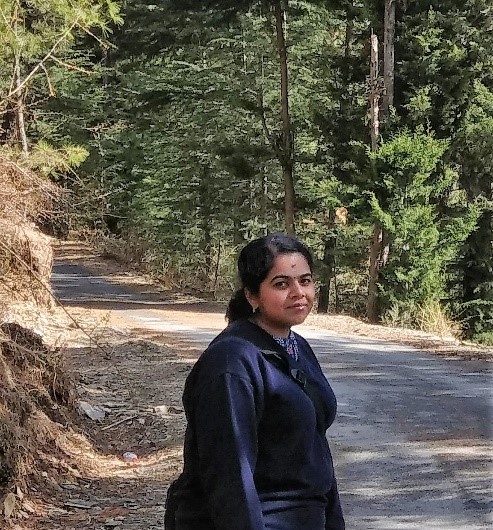
Ramanujan Faculty Fellow
Solid State and Structural Chemistry Unit
Indian Institute of Science,
Bangalore- 560012, India
Email: jayashreen@iisc.ac.in
Google scholar link
Homepage
Sunlight is a multi-faced source of energy since it impacts life through intricately woven networks of beneficial as well as harmful biophysical and biochemical transformations. This suggests that the effects of photoexcited electrons on downstream processes is subtle and mechanistic insights into such light-induced electronic processes in natural and artificial systems can result in novel ways to utilize sunlight for constructive purposes. Our primary interests lie in understanding light-induced vibronic phenomena, focusing specifically on photovoltaic applications and combating ultraviolet light induced aggregation of biomolecules, using first-principles based theories, mixed quantum-classical and quantum mechanical-molecular mechanics algorithms.
If you are a student (undergraduate, Int. Ph.D. or Ph.D.) of IISc and want to work with me, please email me.
A postdoc position is available in my group. If you are interested, please email me with your latest CV, names of 2 people who can write recommendation letters for you and a one-page summary of your Ph.D. thesis. I am also happy to help applicants apply for external fellowships such as National Postdoc Fellowship (NPDF) or Department of Biotechnology-RAships and so on.
Representative publications: (* co-first author)
(1) Cross-talk between overlap interactions in biomolecules: A case study of the beta-turn motif, Molecules, 2021, 26, 1533. DOI: 10.3390/molecules26061533
(2) Double domain swapping in Human γC and γD crystallins drives early stages of aggregation, J. Phys. Chem. B, 2021, 125, 1705. DOI: 10.1021/acs.jpcb.0c07833
(3) High resolution ensemble description of metamorphic and intrinsically disordered proteins using an efficient hybrid parallel tempering scheme, Nat. Comm, 2021, 12, 958. DOI: 10.1038/s41467-021-21105-7
(4) Increasing protein stability by engineering the n → π* interaction at the β-turn, Chemical Science, 2020, 11, 9480-9487. DOI: 10.1039/D0SC03060K
(5) Origin of Luminescence‐Based Detection of Metal Ions by Mn–Doped ZnS Quantum Dots, ChemistrySelect, 2019, 4, 13551- 13557. DOI: 10.1002/slct.201903769
(6) Deuterium isotope effect in fluorescence of gaseous oxazine dyes, M. Kusinki*, J. Nagesh*, M. Gladkikh, A. F. Izmaylov and R. A. Jockusch, Physical Chemistry Chemical Physics, 2019 (DOI: 10.1039/C8CP05731A)
(7) Localized operator partitioning method for electronic excitation energies in the time-dependent density functional formalism, J. Nagesh, M. J. Frisch, P. Brumer, A. F. Izmaylov, The Journal of Chemical Physics 145 (2016), 244111 (DOI: 10.1063/1.4972990)
(8) New Insights into the State Trapping of UV-Excited Thymine, L. Stojanović, S. Bai, J. Nagesh, A. F. Izmaylov, R. Crespo-Otero, H. Lischka, M. Barbatti, Molecules 21 (2016), 1603 (DOI: 10.3390/molecules21111603)
(9) Fast numerical evaluation of time-derivative nonadiabatic couplings for mixed quantum–classical methods, I. G. Ryabinkin*, J. Nagesh*, A. F. Izmaylov, The Journal of Physical Chemistry Letters 6 (2015), 4200-4203 (DOI: 10.1021/acs.jpclett.5b02062)
(10) An efficient implementation of the localized operator partitioning method for electronic energy transfer, J. Nagesh, A. F. Izmaylov, P. Brumer, The Journal of Chemical Physics 142 (2015), 084114 (DOI: 10.1063/1.4908564)
(11) Conformational heterogeneity in the Hsp70 chaperone‐substrate ensemble identified from analysis of NMR‐detected titration data, A. Sekhar, J. Nagesh, R. Rosenzweig, L. E. Kay, Protein Science 26 (2017), 2207-2220 (DOI: 10.1002/pro.3276)
(12) Effects of maturation on the conformational free-energy landscape of SOD1, R. M. Culik, A. Sekhar, J. Nagesh, H. Deol, J. A. O. Rumfeldt, E. M. Meiering, L. E. Kay, Proceedings of the National Academy of Sciences 115 (2018), E2546-E2555 (DOI: 10.1073/pnas.1721022115)
(13) Promiscuous binding by Hsp70 results in conformational heterogeneity and fuzzy chaperone-substrate ensembles, R. Rosenzweig, A. Sekhar, J. Nagesh, L. E. Kay, eLife 2017;6:e28030 (DOI: 10.7554/eLife.28030.001)
.
